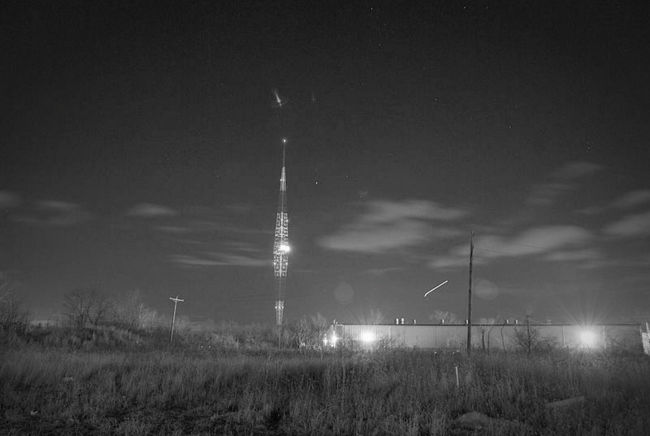
WLW’s diamond-shaped Blaw-Knox radio tower at night (Original photo by RP Piper via Creative Commons 2.0)
(Source: National Endowment for the Humanities)
For a Brief Time in the 1930s, Radio Station WLW in Ohio Became America’s One and Only “Super Station”
When President Franklin Roosevelt, sitting in the White House, pushed a ceremonial button on his desk in May 1934, a five hundred thousand-watt (500 kW) behemoth stirred in a field outside Cincinnati. Rows of five-foot glass tubes warmed. Water flowed around them at more than six hundred gallons per minute. Dozens of engineers lit filaments and flipped switches, and, within the hour, enough power to supply a town of one hundred thousand coursed through an 831-foot tower.
Thus began WLW’s five-year, twenty-four-hour-a-day experiment: a radio station that used more power and transmitted more miles than any station in the United States had or would. The so-called super station—licensed by the new Federal Communications Commission (FCC) on a temporary basis—amped up the debate among broadcasters, government regulators, and listeners about how radio should be delivered to serve the “public interest,” a mandate laid out in the Radio Act of 1927, and influenced legal, programming, and technical decisions that shape the broadcast system we know today.
Since radio’s beginnings in the early 1920s, industry and government leaders promoted it as the great homogenizer, a cultural uplift project that could, among other things, help modernize and acculturate rural areas. The challenge was how to reach these areas, many of which received few or no radio signals in the mid-1930s. One solution was high-powered, clear-channel stations that could blanket large swaths of the country with a strong signal. These stations operated on “cleared” frequencies that the government assigned to only one station to prevent interference.
WLW had operated on one of forty designated clear channels since 1928. The station’s creator and owner, an entrepreneur, inventor, and manufacturer named Powel Crosley Jr. frequently increased the station’s wattage as technology and regulation allowed. In 1934, when WLW increased its power from 50 kW to 500 kW, all other clear-channel stations were operating at 50 kW or less. Now, WLW had the ability to reach most of the country, especially at night, when AM radio waves interact differently with the earth’s ionosphere and become “skywaves.” People living near the transmitter site often got better reception than they wanted; some lights would not turn off until WLW engineers helped rewire houses. Gutters rattled loose from buildings. A neon hotel sign near the transmitter never went dark. Farmers reported hearing WLW through their barbed-wire fences.
